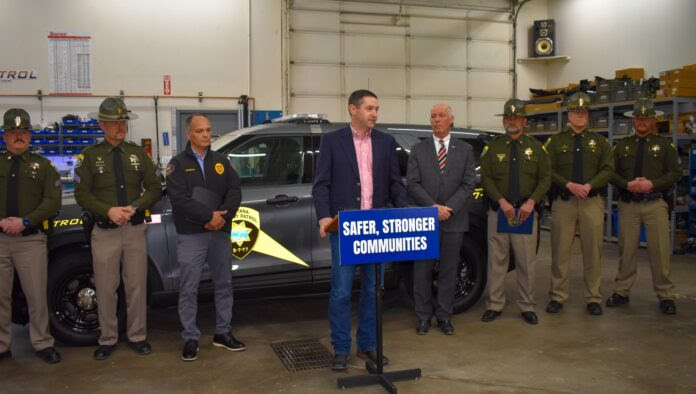BOZEMAN – Over 100 law enforcement officials, criminal prosecutors, advocacy groups, public health officials, and private industry leaders joined Attorney General Austin Knudsen today in Bozeman to discuss efforts and effective strategies to combat human trafficking and commercial sexual exploitation in Montana. Today’s event was the fourth anti-human trafficking symposium Attorney General Knudsen has hosted since taking office.
Building on the work done at the previous symposiums, the three main topics discussed at the event were law enforcement and prosecution, victim services and long-term care, and emerging threats. Attendees also participated in a case study exercise tailored to their role in combatting the problem, holding traffickers accountable, and caring for survivors.
“Human trafficking is modern day slavery, and I remain committed to doing everything I can to end it in Montana,” Attorney General Knudsen said. “I’m proud of what we’ve done at the Montana Department of Justice to fight human trafficking over the last three years, but we won’t solve this problem alone. The groups involved in today’s discussions and private citizens also play an important role in our mission to help survivors and hold perpetrators accountable.”
Since Attorney General Knudsen began sounding the alarm in 2021, reported human trafficking cases have more than doubled. In 2023, Department of Justice agents tracked 147 human trafficking cases in Montana, an increase of 39 percent from 106 cases in 2022 and more than double the 68 cases in 2021. In 2015, there were just seven reported cases statewide.
During the 2023 legislative session, Attorney General Knudsen’s office helped write and pass House Bill 112, which was developed from discussions at previous symposiums. The new law increases the penalties for sex traffickers and patrons of sex trafficking. It also provides prosecutors with more tools to prosecute sex traffickers and expands the definition of human trafficking and has helped intensify the crackdown on the sexual abuse of children and all victims.
The legislation is already helping law enforcement crack down on sex trafficking. For example, last year, officials in Bozeman conducted a sting operation and arrested 18 individuals who were charged with 18 counts of patronizing a prostitute, five counts of criminal distribution of dangerous drugs, one count of resisting arrest, and one count of patronizing a victim of sex trafficking for a child victim.
Attorney General Knudsen also successfully advocated for two new human trafficking agents during the last legislative session, increasing the number agents to investigate human trafficking from two to four.
Attorney General Knudsen has also increased human trafficking training for county attorneys, Montana Highway Patrol Troopers, and law enforcement cadets at the Montana Law Enforcement Academy. He helped launch the Sentinel Project, a private-public partnership between the Montana Department of Justice and non-governmental organizations to increase human trafficking training and public education in the state.
Potential indicators of sex trafficking may include:
- Young person that is very hesitant to engage in conversation. Eyes are always downcast, avoiding eye contact, especially with men. Poor physical state…tired, malnourished, or shows signs of physical abuse or torture.
- Seems to have trouble responding to what their name is or what location (city or even state) they are in. (Victims’ names are often changed, as are their whereabouts. They typically do not stay in one location for long – at times for 24 hours or less).
- Wearing clothes that do not fit the climate or the situation such as short shorts or skirts, tank tops, and no jacket in the middle of winter.
- Lack of control over money, personal possessions like bags, ID’s, or documents. May also be carrying very few possessions in a plastic bag.
- May be accompanied by a dominating person, or someone they seem fearful of. That controlling person may also be someone who does not seem to “fit,” such as a much older individual, an individual of a different race, or with behavior seemingly inappropriate with the suspected victim.
- Young girl or boy hanging around outside a convenience store, truck stop, casino, or other location. May be approaching different vehicles or men they do not seem to know.
If you believe you witness human trafficking:
- If the situation is an emergency, call 911.
- Do not intervene if you see suspected trafficker(s). Remain at a safe distance or in your vehicle.
- In non-emergency situations, call or text 1-833-406-STOP (7867) OR reach and advocate via live chat at 406stop.com
- When possible, take images with your cellular device of the suspected trafficker(s), victim(s), and vehicle license plate(s).




